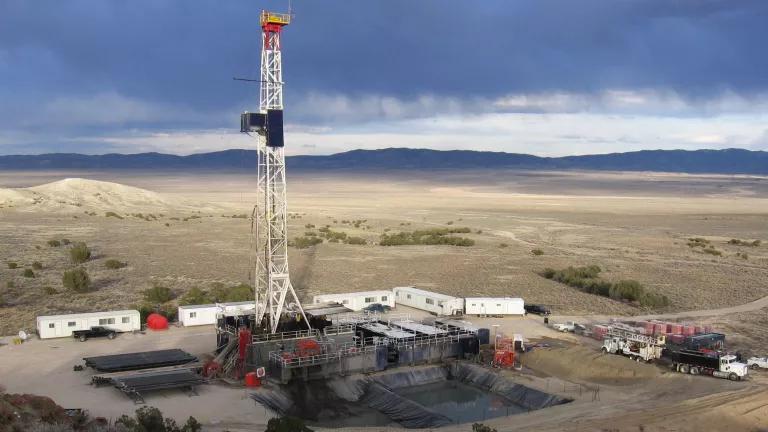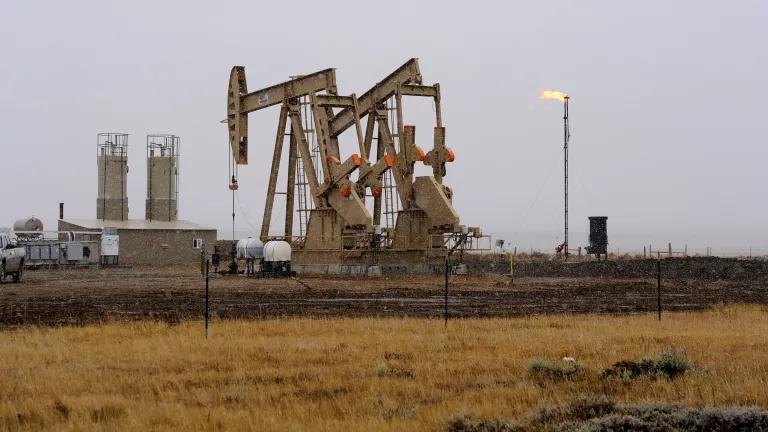Attempt to Block O&G Rule Is Another Industry Handout, Harms Taxpayers
An effort in Congress to roll back federal oil and gas rules would cheat taxpayers, hand industry more free passes, and run counter to recent legislation.

A pumpjack intrudes on Wyoming's sagebrush steppe.
Bureau of Land Management
When the Bureau of Land Management finalized its onshore oil and gas leasing rule in April 2024, it completed work that government watchdogs and frontline communities had been calling on the agency to finish for decades. Now, some members of Congress are looking to permanently hamstring the BLM’s ability to efficiently run the onshore oil and gas program—a move that could cost taxpayers hundreds of millions of dollars in lost revenues and new liabilities.
How can Congress do this? The answer is the Congressional Review Act (CRA), a law that gives Congress the ability—via the passage of bills known as “joint resolutions of disapproval”—to ham-handedly veto actions of the Executive branch of government by overturning regulations that it doesn’t like. The theory behind the CRA is that, because administrative authority is granted to Executive agencies by Congress, Congress should have some oversight over what agencies do with that authority. Sadly, however, the CRA is often used as a blunt instrument to stall reform and score political points. And that is exactly what is happening here, where such resolutions were recently introduced in both the House and Senate.
As a refresher, the BLM’s oil and gas leasing rule is largely an implementation plan for carrying out reforms passed by Congress in the Inflation Reduction Act (IRA). These reforms are hard-wired into current law and apply to the onshore oil and gas program regardless of whether Congress succeeds in blocking this rule or not. In a nutshell, these reforms include:
- Higher royalty rates, which will rise from 12.5 percent to 16.67 percent—or at least 20 percent for reinstated leases—through 2032. After 2032—when the IRA’s fiscal terms expire—royalty rates will remain set at 16.67 percent.
- Higher minimum bids—which companies offer during a lease auction to secure the right to lease lands for oil and gas production—will rise from $2/acre to at least $10/acre through 2032. Following expiration of the IRA, the final rule ties further minimum bid increases to inflation.
- Higher rental rates, which will rise from $1.50/acre to $3/acre. Rents will then increase in defined intervals to encourage development or lease relinquishment, with rents topping out at $15/acre after year nine or $20/acre for reinstated leases. Following expiration of the IRA, the final rule ties further rent increases to inflation.
- An “expression of interest” fee of $5/acre on companies looking to nominate—or suggest—acres for lease at a future lease sale.
- An end to non-competitive leasing, which allowed companies to anonymously procure leases at cut-rate prices but rarely resulted in development of those leases.
Industry likes to frame this rule as being solely responsible for raising all these fees, but that’s a red herring that tries to distract from two important truths. First, Congress raised these fees in law, and it did so because watchdogs like the Government Accountability Office had flagged them as being woefully low for decades—a situation that was driving speculation, but not development of mineral resources. Second, across the board, these fees generally just align with the rates charged on state lands where oil and gas activities take place. In other words, at most the IRA provisions implemented by this rule level the playing field.
The second suite of reforms in the rule update regulations that existed long before the IRA, and that history has shown to be insufficient to ensure responsible development of federal lands. Like the rule’s underpinnings in the IRA, these reforms are based squarely on long-standing congressional authorities in the Mineral Leasing Act and the Federal Land Policy and Management Act. Specifically, the rule:
- Increases bonding rates from $10,000 to $150,000 per lease, and statewide bonding for multiple wells from $25,000 to $500,000. In addition, the rule ends the horrendous practice of nationwide bonding, which allowed industry to cover all its liabilities nationwide with a single, minimal bond valued far below the actual cleanup costs a company incurs during oil and gas production. Under the old regulations, bonding levels were so low that BLM only held $2,100 per well in 2018, a figure at least 10 times smaller than the cost of plugging and remediating the cheapest and simplest oil and gas wells. This is a critical change because there are currently more than 90,000 open well bores on federal public lands that will need to be plugged—a figure that represents an enormous, uncovered liability to U.S. taxpayers should bond levels not be raised.
- Formally adopts existing guidance on the BLM’s use of preference criteria to screen nominated lease parcels for potential conflicts with other important values like wildlife habitat, cultural resources, sacred sites, and lands used for recreation. This approach has allowed the BLM to better steer leasing and development only to those areas with a strong likelihood of being developed.
- Sets a three-year term for newly issued drilling permits, which will now expire unless developers begin work on their leases. This change seeks to encourage diligent development on leases, lower administrative costs on the overburdened BLM, and limit permit stockpiling.
If Congress were to succeed in blocking this rule, not only would it be scrapped from the books, under the terms of the CRA the BLM would be barred from ever issuing a similar rule in the future. That would mean the oncoming threat of unpaid liabilities created by insufficient bonding would begin to come due, and history has shown that taxpayers—not industry—would be on the hook. But blocking the rule would also result in chaos, inefficiency, and higher costs for the BLM as it attempts to implement the IRA’s fiscal reforms without the certainty of an enforceable implementing regulation. That could jeopardize millions of dollars of revenue generated by oil and gas rents and royalties that this rule is designed to help the BLM efficiently manage and collect.
If passed, a joint resolution of disapproval striking down the onshore oil and gas leasing rule would circumvent and undermine the administrative process, effectively prohibiting the BLM from doing its job to oversee the federal leasing program. It would also undermine public support for the rule, which was overwhelming. During the rule’s 60-day comment period, more than 250,000 public comments were submitted, with more than 99 percent of them speaking up in favor of the rule’s promulgation. This attempt by Congress to subvert the administrative process and go against the will of the public is nothing but an attempt to pass along another handout to an industry raking in record profits.
This foolhardy legislative effort should be treated with the seriousness it deserves and set aside. The oil and gas industry has profited by locking up our shared public lands for long enough.



